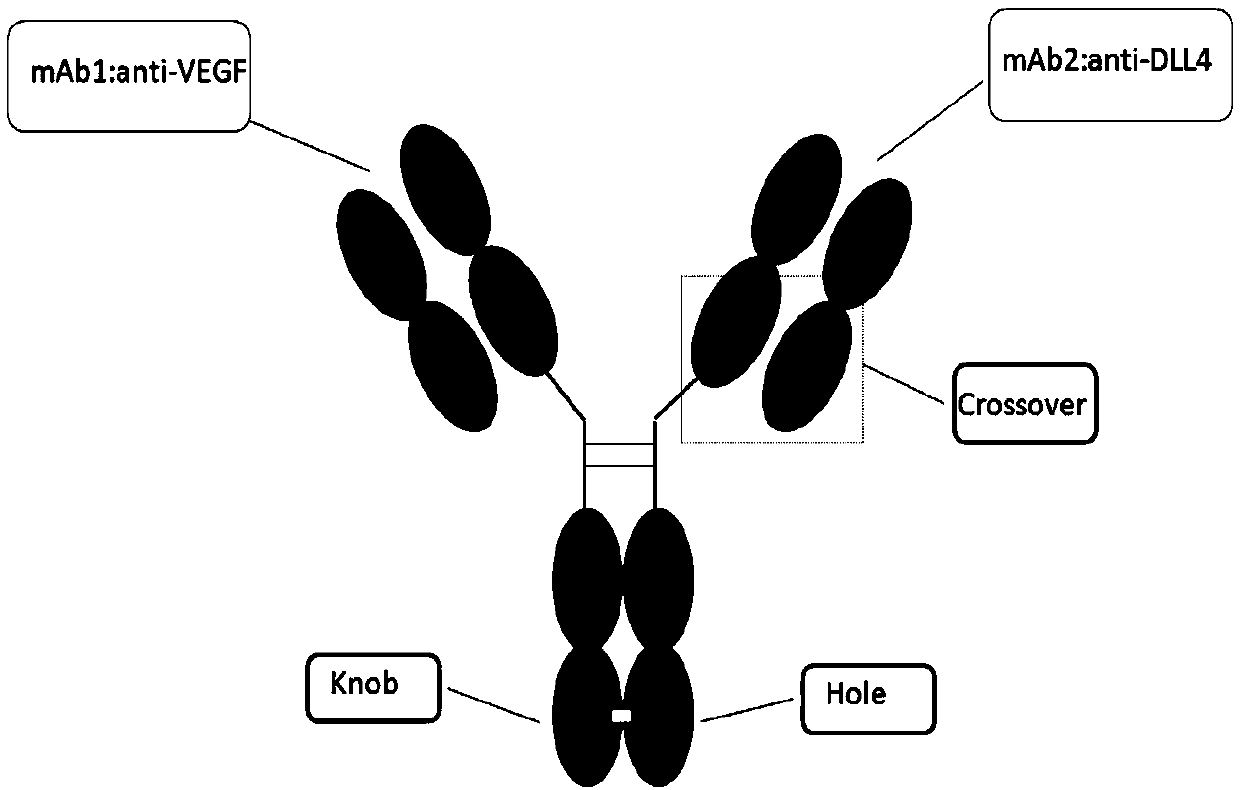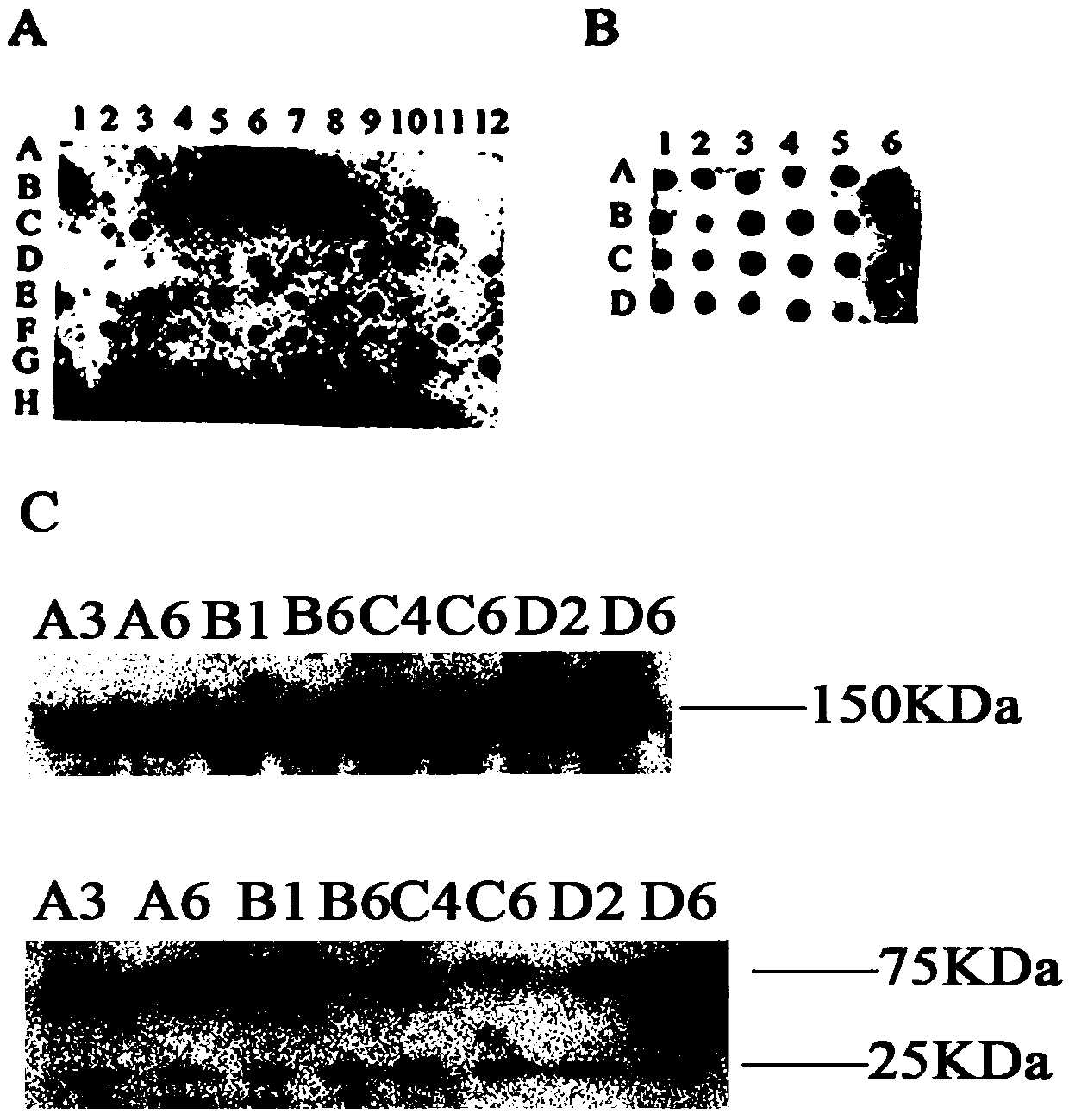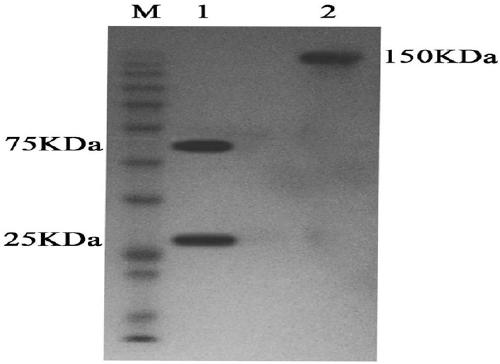Anti-human DLL4 and VEGF bispecific antibody and preparation and application thereof
A bispecific antibody and antibody technology, applied in the direction of antibody, application, anti-animal/human immunoglobulin, etc., can solve the problems of abnormal increase of adverse blood vessels, reduction of tumor blood supply, reduction of vascular system, etc., and achieve high inhibitory effect , good antitumor activity
- Summary
- Abstract
- Description
- Claims
- Application Information
AI Technical Summary
Problems solved by technology
Method used
Image
Examples
Embodiment 1
[0038] Example 1 Construction of bispecific antibody protein HB-32 targeting VEGF and DLL4
[0039] The resulting dual-targeting VEGF and DLL4 bispecific antibody HB-32 is composed of four chains, one side of which is derived from Bevacizumab, and an original heavy chain of Bevacizumab is designed with a Knob structure, which has the amino acid shown in SEQ ID NO:1 The sequence has the nucleotide sequence shown in SEQ ID NO: 5; an original light chain of Bevacizumab remains unchanged, it has the amino acid sequence shown in SEQ ID NO: 2, and has the nucleotide sequence shown in SEQ ID NO: 6. On the other side, using H3L2 as the parent monoclonal antibody, a new modified heavy chain and a new modified light chain were designed. The heavy chain introduced three "Hole" mutations (T396S, L398A, Y437V) and a Cysteine residue (Y379C), it has the aminoacid sequence shown in SEQ IDNO:3, has the nucleotide sequence shown in SEQ IDNO:7; And new light chain is by H3L2 original heavy fr...
Embodiment 2
[0044] Example 2 Screening of Antibody Stable Expression Cell Lines
[0045] CHO-s cells were electroporated and co-transfected with the successfully constructed vector plasmids above, and the electroporation and co-transfection conditions were 160V, 15ms. After 24 hours, add G418 for selection (final concentration is 700 μg / mL), and change the medium every 2 to 3 days. After about 10 days, cell clones are formed, and single clones are picked and cultured in 96-well plates. After most of the cells in the wells grow When the confluence reached more than 80%, the supernatant was drawn to do Dot blot, and the expression of the target protein in the supernatant was semi-quantitative. According to the semi-quantitative results, cells with higher expression levels were selected and cloned into 24-well plates for further culture. After 5 to 7 days, perform Dot blot on the supernatant, select positive clones with high expression yield and transfer them to T-25 cell culture flasks for ...
Embodiment 3
[0047] Example 3 Expression and purification of antibodies
[0048] The cell culture supernatant was suction-filtered with a 0.22 μm water-based filter membrane, and then loaded into the Protein A chromatography column through a constant-flow pump. After the sample was loaded, it was equilibrated with a balance solution for 20 minutes. The samples were then eluted with pH 3.0 eluent for 10 column volumes. In order to neutralize the acidity in the eluent, 50 μL of Tris-HCL with pH 9.0 was added to each tube in advance to adjust the pH. The eluted samples were concentrated by ultrafiltration, and the antibody concentration was determined using a Bio-Tek protein microquantifier. SDS-PAGE was performed on the protein concentrated by ultrafiltration, and the expression and assembly of the protein were detected in the reduced state and the non-reduced state, respectively.
[0049] see results image 3 .
PUM
 Login to View More
Login to View More Abstract
Description
Claims
Application Information
 Login to View More
Login to View More - R&D
- Intellectual Property
- Life Sciences
- Materials
- Tech Scout
- Unparalleled Data Quality
- Higher Quality Content
- 60% Fewer Hallucinations
Browse by: Latest US Patents, China's latest patents, Technical Efficacy Thesaurus, Application Domain, Technology Topic, Popular Technical Reports.
© 2025 PatSnap. All rights reserved.Legal|Privacy policy|Modern Slavery Act Transparency Statement|Sitemap|About US| Contact US: help@patsnap.com



